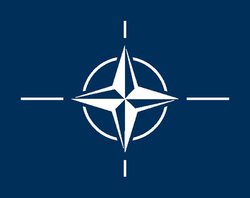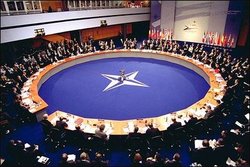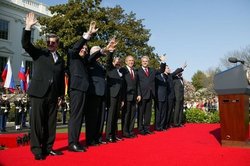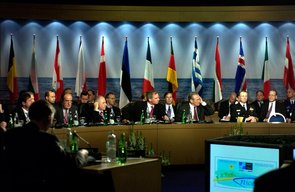NATO
|
|
- This Wikipedia article uses British spelling because of NATO's historical use of this style as a standard1. NATO is also an acronym for the National Association of Theatre Owners.
The North Atlantic Treaty Organisation (NATO), sometimes called North Atlantic Alliance, Atlantic Alliance or the Western Alliance, is an international organisation for defence collaboration established in 1949, in support of the North Atlantic Treaty signed in Washington, D.C., on April 4, 1949. Its other official name is the French equivalent, l'Organisation du Traité de l'Atlantique Nord (OTAN).
The core provision of the treaty is Article V, which states:
- The Parties agree that an armed attack against one or more of them in Europe or North America shall be considered an attack against them all. Consequently they agree that, if such an armed attack occurs, each of them, in exercise of the right of individual or collective self-defence recognised by Article 51 of the Charter of the United Nations, will assist the Party or Parties so attacked by taking forthwith, individually and in concert with the other Parties, such action as it deems necessary, including the use of armed force, to restore and maintain the security of the North Atlantic area.
This provision was intended so that if the USSR and its allies launched an attack against the Western European allies of the United States, it would be treated as if it was an attack on all member states, including the United States, which has the largest military in the alliance and could thus provide the most significant retaliation. However, the feared invasion of Western Europe never came. Instead, the provision was invoked for the first time in the treaty's history on September 12, 2001, in response to the September 11 attacks on the United States the day before.
See also: Ranks and Insignia of member nations of NATO
| Contents |
Member states
Map_of_NATO_countries.png
Founding members (April 4, 1949)
- Template:BEL
- Template:CAN
- Template:DEN
- Template:FRA 1966 France withdraws from the integrated command of NATO and all NATO forces leave France
- Template:ISL
- Template:ITA
- Template:LUX
- Template:NLD
- Template:NOR
- Template:POR
- Template:UK
- Template:USA
States that joined NATO during the Cold War
- Template:GRC (February 18, 1952)
- Template:TUR (February 18, 1952)
- Template:GER (May 9, 1955 as West Germany)
- Template:ESP (May 30,1982)
Former Eastern Bloc states that joined NATO after the Cold War
- Template:CZE (May 27, 1999)
- Template:HUN (May 27, 1999)
- Template:POL (May 27, 1999)
- Template:BUL (March 29, 2004)
- Template:EST (March 29, 2004)
- Template:LAT (March 29, 2004)
- Template:LTU (March 29, 2004)
- Template:ROM (March 29, 2004)
- Template:SVK (March 29, 2004)
- Template:SVN (March 29, 2004)
NATO_expansion.png
Greece and Turkey joined the organisation in February 1952. Germany joined as West Germany in 1955 and German reunification in 1990 extended the membership to the areas of the former German Democratic Republic, which became part of the Federal Republic of Germany. Spain was admitted on May 301982, and the former Warsaw Pact countries of Poland, Hungary and the Czech Republic made history by becoming members on March 121999.
France is a member of NATO, but it withdrew from the military command in 1966. Following this decision, the NATO headquarters was moved from Paris to Brussels. Iceland, the sole member of NATO which does not have its own military force (the Icelandic Defense Force being the United States Military contingent permanently stationed in Iceland), joined on the condition that they would not be expected to establish one.
Slovenia, Slovakia, the former Warsaw Pact countries of Bulgaria and Romania, and Estonia, Latvia and Lithuania, previously annexed by the USSR, officially acceded to NATO on March 292004. They attended their first NATO meeting in April 2004.
Political structure
Like any alliance, NATO is ultimately governed by its 26 member states. However, the North Atlantic Treaty, and other agreements, outline how decisions are to be made by NATO. Each of the 26 members sends a delegation or mission to NATO's headquarters in Brussels, Belgium. The senior permanent member of each delegation is known as the Permanent Representative and is generally a senior civil servant or an experienced ambassador. Together the Permanent Members form the North Atlantic Council, a body which meets together at least once a week and has effective political authority and powers of decision in NATO. From time to time the Council also meets at higher levels involving Foreign Ministers, Defence Ministers or Heads of Government and it is at these meetings that major decisions regarding NATO's policies are generally taken. However, it is worth noting that the Council has the same authority and powers of decision-making, and its decisions have the same status and validity, at whatever level it meets.
The meetings of the North Atlantic Council are chaired by the Secretary General of NATO and, when decisions have to be made, action is agreed upon on the basis of unanimity and common accord. There is no voting or decision by majority. Each nation represented at the Council table or on any of its subordinate committees retains complete sovereignty and responsibility for its own decisions.
A second member of each country's delegation is the Military Representative, a senior officer from each country's armed forces. Together the Military Representatives form the Military Committee, a body responsible for recommending to NATO's political authorities those measures considered necessary for the common defence of the NATO area. Its principal role is to provide direction and advice on military policy and strategy. It provides guidance on military matters to the NATO Strategic Commanders, whose representatives attend its meetings, and is responsible for the overall conduct of the military affairs of the Alliance under the authority of the Council. Like the council, from time to time the Military Committee also meets at a higher level, namely at the level of Chiefs of Defence, the most senior military officer in each nations armed forces.
Military structure
NATO's military operations are directed by two Strategic Commanders, both senior American Officers assisted by a staff drawn from across NATO. The Strategic Commanders are responsible to the Military Committee for the overall direction and conduct of all Alliance military matters within their areas of command.
Before 2003 the Strategic Commanders were the Supreme Allied Commander Europe (SACEUR) and the Supreme Allied Commander Atlantic (SACLANT) but the current arrangement is to separate command responsibility between Allied Command Transformation (ACT), responsible for transformation and training of NATO forces, and Allied Command Operations, responsible for NATO operations world wide.
The commander of Allied Command Operations retained the title "Supreme Allied Commander Europe", and is based in the Supreme Headquarters Allied Powers Europe located at Casteau, north of the Belgian city of Mons. This is about 80 km (50 miles) away from NATO's political headquarters. Allied Command Transformation (ACT) is based in the former Allied Command Atlantic headquarters in Norfolk, Virginia.
History
- March 17, 1948: The Benelux countries, France, and the United Kingdom sign the Treaty of Brussels, a precursor to the NATO Agreement.
- May 14, 1955: Warsaw Pact treaty is signed in Warsaw by the Soviet Union and its satellite states as a formal response to NATO. Both organisations are opposing sides in the Cold War. After the fall of the Iron Curtain in 1989, the Warsaw Pact disintegrates.
- 1966: Charles de Gaulle removes France from NATO's military command to pursue its own nuclear defence programme. All non French NATO troops are forced to leave France. This precipitates the relocation of the NATO Headquarters from Paris, France to Brussels, Belgium by October 16, 1967. While the political headquarters are located in Brussels the military headquarters, the Supreme Headquarters Allied Powers Europe (SHAPE), are located just south of Brussels, in the town of Mons.
- May 30, 1978 NATO countries define two complementary aims of the Alliance, to maintain security and pursue détente. This is supposed to mean to keep their defences at the level rendered necessary by the Warsaw Pact's offensive capabilities without spurring a further arms race.
- December 12, 1979 In light of a build-up of Warsaw Pact nuclear capabilities in Europe, ministers approved the deployment of U.S. Cruise and Pershing II theater nuclear weapons in Europe. The new warheads are also meant to strengthen the western negotiating position in regard to nuclear disarmament.
- 1983-84: Soviet activity in the Middle East leads to the end of western détente. Responding to the stationing of Warsaw Pact SS-20 medium-range missiles in Europe, NATO deploys modern Pershing II missiles able to reach Moscow within minutes. This action leads to bitter peace movement protests throughout Western Europe.
- May 1984: A NATO manoeuvre codenamed Able Archer, which simulates a NATO response to a Soviet nuclear attack, causes panic in the Kremlin. Soviet leader Yuri Andropov becomes concerned that Ronald Reagan intends to launch a real first strike, and places Soviet nuclear forces at full readiness. Only after the collapse of the Soviet Union does it become clear that US intelligence had mistaken real Soviet nervousness for propaganda efforts.
- October 3, 1990: With the reunification of Germany, the former East Germany becomes part of the Federal Republic of Germany and the alliance. This had been agreed in the Two Plus Four Treaty earlier in the year. To secure Soviet approval of united Germany remaining in NATO, it is agreed that there will be no new foreign military bases in the east, and that nuclear weapons will not be permanently stationed there.
- March 31, 1991: The Warsaw Pact comes to an end. It is officially dissolved on July 1, 1991. The Soviet Union collapses in December the same year.
- February 8, 1994: NATO takes its first military action, shooting down two Bosnian Serb aircraft violating a UN no-fly zone over central Bosnia and Herzegovina. NATO airstrikes the following year help bring the war in Bosnia to an end, resulting in the Dayton Agreement.
- July 8, 1997: Three former communist countries, Hungary, the Czech Republic, and Poland, are invited to joined NATO. They join in 1999.
- March 24, 1999: NATO sees its first broad-scale military engagement in the Kosovo War, where it wages an 11-week bombing campaign against what was then the Federal Republic of Yugoslavia, aimed at preventing the ethnic cleansing of Albanians. It ends on June 11, 1999, when Yugoslavian leader Slobodan Milosevic agrees to NATO's demands. It is later shown that, although the Yugoslav army was incapacitated, far less of its equipment was destroyed than NATO had estimated.
- April 1999: At the Washington summit, Germany proposes that NATO adopt a no-first-use nuclear strategy; the proposal is rejected.
- September 12, 2001: NATO provisionally invokes, for the first time in its history, the collective security clause of its charter. Article 5 states that any attack on a member state is considered an attack against the entire alliance. This comes in response to the September 11, 2001 Terrorist Attack against the United States.
- October 5, 2001: NATO confirms the invocation of Article 5, having determined that the attacks of 11 September were eligible under the terms of the North Atlantic Treaty. [1] (http://www.nato.int/docu/update/2001/1001/e1002a.htm)
- November 21, 2002: During the Prague summit, seven countries are invited to start talks in order to join the Alliance: Estonia, Latvia, Lithuania, Slovenia, Slovakia, Bulgaria, and Romania. The invited countries join NATO on March 29, 2004. Further countries express the wish to join the alliance, including Albania, the Republic of Macedonia, and Croatia. The summit also launches the NATO Response Force (NRF).
- February 10, 2003: NATO faces a crisis when France and Belgium veto the procedure of silent approval concerning the timing of protective measures for Turkey in case of a possible war with Iraq. Germany does not use its right to break the procedure but says it supports the veto.
- April 16, 2003: NATO agrees to take command in August of the International Security Assistance Force (ISAF) in Afghanistan. The decision comes at the request of Germany and the Netherlands, the two nations leading ISAF at the time of the agreement. All 19 NATO ambassadors approve it unanimously. The handover of control to NATO takes place on August 11, and marked the first time in NATO's history that it takes charge of a mission outside the north Atlantic area. Canada had originally been slated to take over ISAF by itself on that date.
- June 19, 2003: A major restructuring of the NATO military commands begins as the Headquarters of the Supreme Allied Commander, Atlantic was abolished and a new command, Allied Command Transformation, was established in Norfolk, Virginia, U.S.
Secretaries General of NATO
- Lord Ismay (United Kingdom): April 4, 1952, to May 16, 1957
- Paul-Henri Spaak (Belgium): May 16, 1957, to April 21, 1961
- Dirk Stikker (Netherlands): April 21, 1961, to August 1, 1964
- Manlio Brosio (Italy): August 1, 1964, to October 1, 1971
- Joseph Luns (Netherlands): October 1, 1971, to June 25, 1984
- Lord Carrington (United Kingdom): June 25, 1984, to July 1, 1988
- Manfred Wörner (Germany): July 1, 1988, to August 13, 1994
- Sergio Balanzino (Italy, acting): August 13, 1994, to October 17, 1994
- Willy Claes (Belgium): October 17, 1994, to October 20, 1995
- Sergio Balanzino (Italy, acting): October 20, 1995, to December 5, 1995
- Javier Solana (Spain): December 5, 1995, to October 6, 1999
- Lord Robertson of Port Ellen (United Kingdom): October 14, 1999, to January 1, 2004
- Jaap de Hoop Scheffer (Netherlands): January 1, 2004, to present
Debate on the future of NATO
The crumbling of the main "Enemy of the West" in Eastern Europe, as well as dissensions between members about the latest Iraq operations, makes some wonder – in North America as well as in Europe – if NATO has not become obsolete. The presumed terrorist threat could give this institution a new life, but some think also that fighting this new enemy needs a completely different political and military organisation, as well as completely different weapons systems other than those on which NATO was built.
Many also argue that NATO is in conflict with the prospects of deeper European integration in the fields of foreign policy and security within the framework of the EU institutions. Advocates for a strong EU Common Foreign and Security Policy (CFSP) would like to see NATO dismantled and create common defence and foreign policy within the existing EU institutions.
In November 2004 after the re-election of President George W. Bush the Norwegian Prime Minister Kjell Magne Bondevik publicly discussed whether Norway would gain by strengthening her defence relations with the EU. Many Norwegian political analysts consider NATO to be a "politically dead organisation". So do several pundits and political leaders in other member nations. These attitudes will of necessity be reflected in future discussions of NATO expansion.
See also
- Euro-Atlantic Partnership Council
- OSCE
- Partnership for Peace
- WEU
- UN
- Atlantic Council
- Headquarters Allied Command Europe Rapid Reaction Corps
- Warsaw pact
- Non-Aligned Movement
- NATO Medal
- silence procedure
External links
- NATO Official Website (http://www.nato.int/)
- NATO Maintenance and Supply Agency (NAMSA) Official Website (http://www.namsa.nato.int/)
- NATO Response Force Article (http://www.army-technology.com/contractors/missiles/nato.html)
- Official Article on NATO Response Force (http://www.nato.int/issues/nrf/index.html)
- Basic NATO Documents (http://www.nato.int/docu/basics.htm)
- NATO searches for defining role (http://news.bbc.co.uk/2/hi/europe/4232381.stm)
- 'NATO force 'feeds Kosovo sex trade' - The Guardian (http://www.guardian.co.uk/international/story/0,,1211214,00.html)
Notes
Note 1: This convention is discussed in NATO's online frequently asked questions (http://www.nato.int/issues/faq/index.html#C4): "Q: Why do you spell organisation with an sand not a z? A: By tradition, NATO uses European English spellings in all public information documents...". NATO has two official languages, English and French, this is defined in Article 14 of the North Atlantic Treaty.
bg:НАТО ca:OTAN cs:Severoatlantická aliance cy:Sefydliad Cytundeb Gogledd yr Iwerydd da:NATO de:NATO et:NATO es:Organización del Tratado del Atlántico Norte eo:NATO fr:Organisation du traité de l'Atlantique Nord gl:OTAN ko:북대서양 조약 기구 hi:नैटो hr:NATO io:NATO id:NATO ia:OTAN is:Atlantshafsbandalagið it:NATO he:נאט"ו ku:NATO lv:NATO lt:NATO hu:NATO mk:НАТО nl:NAVO ja:北大西洋条約機構 nb:NATO nn:NATO pl:NATO pt:Organização do Tratado do Atlântico Norte ro:Organizaţia Tratatului Atlanticului de Nord ru:НАТО se:NATO sk:Severoatlantická aliancia sl:NATO sr:НАТО fi:NATO sv:NATO th:องค์การสนธิสัญญาป้องกันแอตแลนติกเหนือ vi:NATO tr:NATO uk:НАТО zh:北大西洋公约组织




